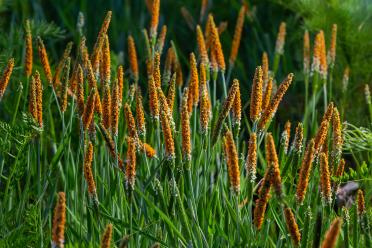
Two new Alopecurus genomes have been sequenced, providing important additions to the growing body of community resources for weed genomics.
Access to the genomes for blackgrass and orange foxtail, sometimes called shortawn foxtail, will help researchers address what makes these weeds such exceptional survivors in modern agricultural systems.
The sequencing of the orange foxtail genome, which was carried out at the Earlham Institute, generated 11.7 million PacBio HiFi reads - nearly 230 Gb of data - corresponding to a haploid genome coverage of 32.9x.
Both blackgrass (Alopecurus myosuroides) and orange foxtail (Alopecurus aequalis) are native to many regions across the Northern Hemisphere.
Blackgrass has become the predominant agricultural weed in Western European winter wheat and barley, whereas orange foxtail has emerged as the dominant agricultural weed for similar crops in parts of China and Japan.
Both are grass weeds that grow in grass crops. They frequently out-compete cereal crops.
Changes in cropping practices have not been effective in controlling the weeds, and both have evolved resistance to multiple herbicides.
With both weeds presenting a major threat to crop yields and food security, a better understanding of the genetic drivers of their resistances and resiliencies are essential to generate effective strategies for control. Filling this knowledge gap requires high-quality genomic resources.
In December 2023, an annotated blackgrass genome was published by Rothamsted, Clemson University, and Bayer scientists. The blackgrass seeds were from a population collected in 2017 from the Broadbalk long-term experiment that had never been treated with herbicides and so remained susceptible to chemical control.
Comparing this population with resistant populations from other UK fields enabled these researchers to identify genetic mechanisms correlated with resistance.
Now, one year later, an annotated orange foxtail genome has been published. For this genome, Rothamsted researchers collaborated with partners at the Earlham Institute and the European Reference Genome Atlas (ERGA) initiative, which ultimately aims to provide reference genomes for all European species.
The orange foxtail plants sequenced were from seeds held by Kew’s Millennium Seed Bank from a UK-collected population.
As orange foxtail is not present in the UK’s agroecosystem, it is unlikely they have ever been exposed to herbicides.
As with the Broadbalk seeds, this genome is an important reference as it will not have been influenced by the strong selective pressures that have shaped some weed populations.
The orange foxtail genome at 2.83 Gb is smaller than the blackgrass genome (3.572 Gb) and contained just over 33,750 protein-coding genes. The genome is assembled into a total of seven chromosome-level scaffolds, and most are complete with telomere sequences on one or both ends.
The sequencing, assembly, and analysis of the orange foxtail grass were carried out by teams in both the Earlham Institute’s Faculty and its National Bioscience Research Infrastructure in Transformative Genomics, both supported by BBSRC.
Dr Jon Wright, study author and Bioinformatician at the Earlham Institute, said: “Genomic resources are increasingly important to enable breeders and producers, who are under growing pressure to develop new and sustainable approaches to manage weeds, pests, and disease.
“To understand how these weeds compete with the plants we want to cultivate, and look inside the box of tricks they use to frustrate farmers, we absolutely need to have high-quality genomes.
“We’ve been able to start exploring the evolutionary story of these weeds, particularly their development of herbicide resistance. This could be used to develop effective herbicides or other strategies to better control these weeds.”
Dr Dana MacGregor, author and Weed Molecular Biologist at Rothamsted Research, said: “With these platinum-quality genomes in hand, we can shrink the continental-scale geographic isolation and 7.4 million years of divergence between these two species to ask whether similarities between these two species are the result of parallel evolution or have a common origin.
“When we compared the orange foxtail and blackgrass genomes with barley - a crop they grow in - we were surprised to find that the orange foxtail genome structure is more like barley than blackgrass.
“Such genomic rearrangements highlight areas of functional conservation or divergence that drive adaptations to specific environments or ecological niches.”
The genome for the orange foxtail was sequenced by the Technical Genomics group, assembled by Dr Wright, and annotated by the Core Bioinformatics group - all based at the Earlham Institute.
Naomi Irish, Senior Research Assistant in the Technical Genomics Group at the Earlham Institute, said: “The orange foxtail is quite exceptional amongst eukaryotic genome assemblies. We normally see very good assemblies with a contig N50 of between 20-30Mb. Our orange foxtail has a huge contig N50 of 374.7Mb.
“Assembling the genome - from growing the plants, doing the DNA extraction, through to sequencing and annotation - involves a lot of people and expertise. We’re uniquely set up to bring everyone and everything together for these kinds of projects to give us such great coverage.
“The read length, particularly for a plant, was particularly impressive and only made possible thanks to careful coordination and collaboration.”
ERGA contributes to the Earth BioGenome Project (EBP). This ambitious initiative aims to sequence all eukaryotic life on earth - generating reference quality genome assemblies for approximately 1.9 million described eukaryotes.


